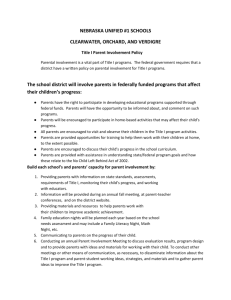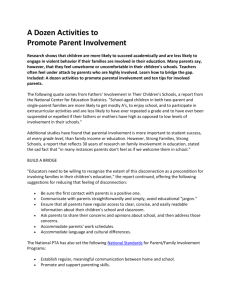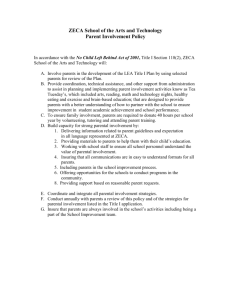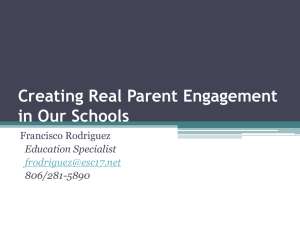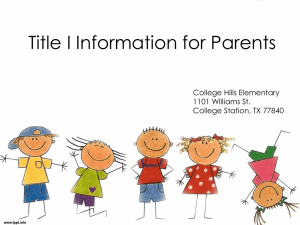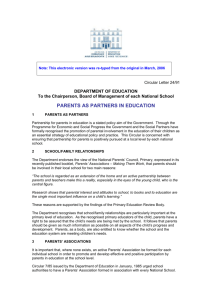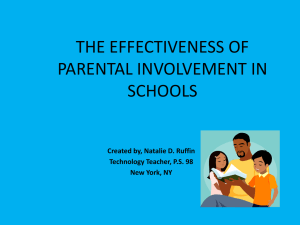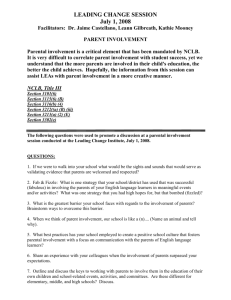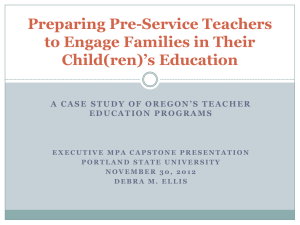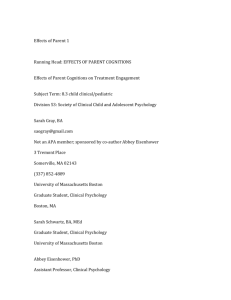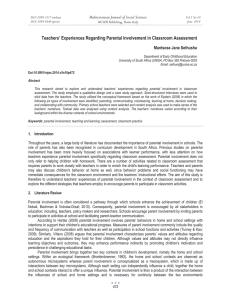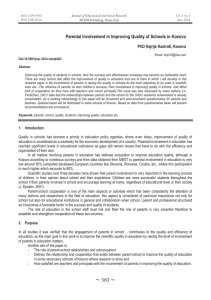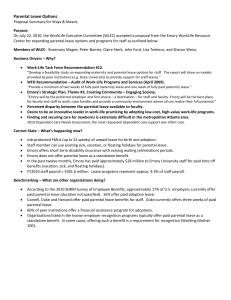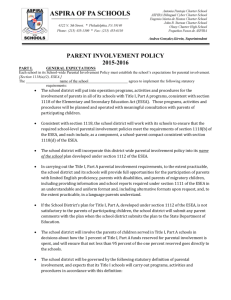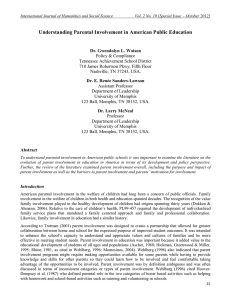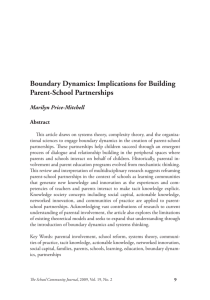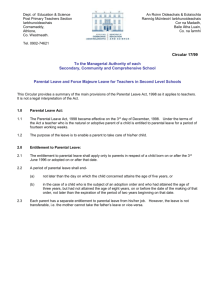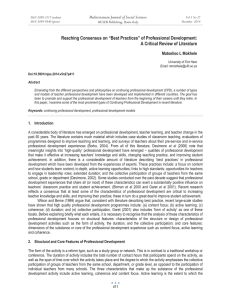Fact Sheet on Parent Involvement in children`s education
advertisement
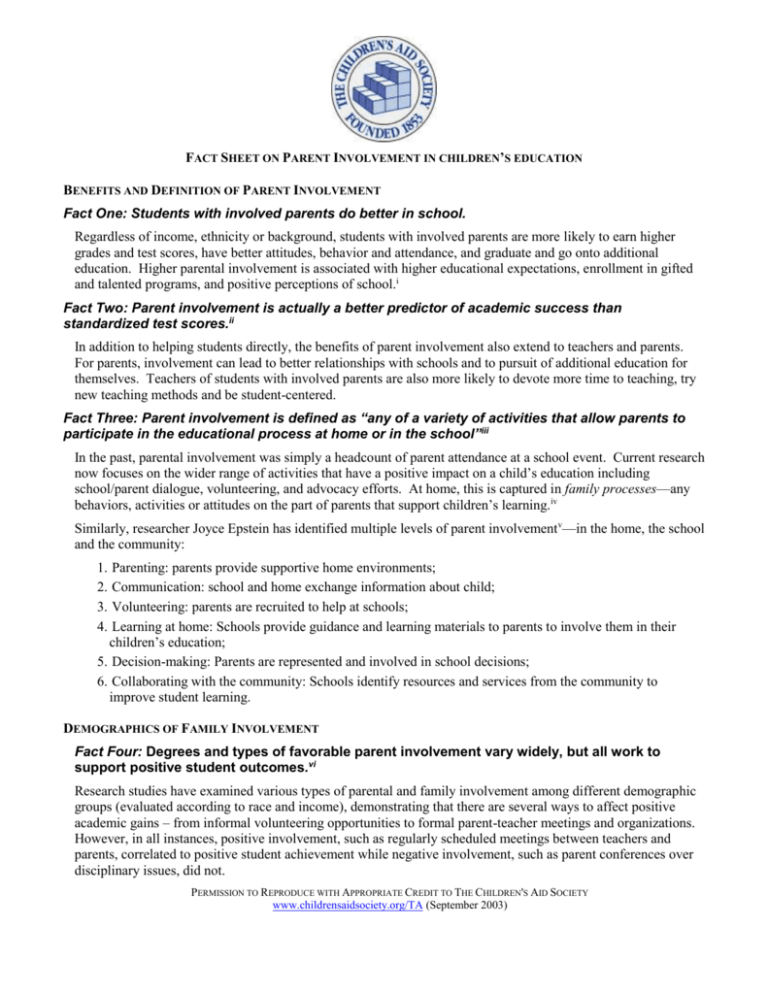
FACT SHEET ON PARENT INVOLVEMENT IN CHILDREN’S EDUCATION BENEFITS AND DEFINITION OF PARENT INVOLVEMENT Fact One: Students with involved parents do better in school. Regardless of income, ethnicity or background, students with involved parents are more likely to earn higher grades and test scores, have better attitudes, behavior and attendance, and graduate and go onto additional education. Higher parental involvement is associated with higher educational expectations, enrollment in gifted and talented programs, and positive perceptions of school.i Fact Two: Parent involvement is actually a better predictor of academic success than standardized test scores.ii In addition to helping students directly, the benefits of parent involvement also extend to teachers and parents. For parents, involvement can lead to better relationships with schools and to pursuit of additional education for themselves. Teachers of students with involved parents are also more likely to devote more time to teaching, try new teaching methods and be student-centered. Fact Three: Parent involvement is defined as “any of a variety of activities that allow parents to participate in the educational process at home or in the school”iii In the past, parental involvement was simply a headcount of parent attendance at a school event. Current research now focuses on the wider range of activities that have a positive impact on a child’s education including school/parent dialogue, volunteering, and advocacy efforts. At home, this is captured in family processes—any behaviors, activities or attitudes on the part of parents that support children’s learning.iv Similarly, researcher Joyce Epstein has identified multiple levels of parent involvementv—in the home, the school and the community: 1. 2. 3. 4. Parenting: parents provide supportive home environments; Communication: school and home exchange information about child; Volunteering: parents are recruited to help at schools; Learning at home: Schools provide guidance and learning materials to parents to involve them in their children’s education; 5. Decision-making: Parents are represented and involved in school decisions; 6. Collaborating with the community: Schools identify resources and services from the community to improve student learning. DEMOGRAPHICS OF FAMILY INVOLVEMENT Fact Four: Degrees and types of favorable parent involvement vary widely, but all work to support positive student outcomes.vi Research studies have examined various types of parental and family involvement among different demographic groups (evaluated according to race and income), demonstrating that there are several ways to affect positive academic gains – from informal volunteering opportunities to formal parent-teacher meetings and organizations. However, in all instances, positive involvement, such as regularly scheduled meetings between teachers and parents, correlated to positive student achievement while negative involvement, such as parent conferences over disciplinary issues, did not. PERMISSION TO REPRODUCE WITH APPROPRIATE CREDIT TO THE CHILDREN'S AID SOCIETY www.childrensaidsociety.org/TA (September 2003) Fact Five: Parental involvement declines with the age of students. As children grow older, parents become more uncertain about how to help, while also trying to give their children more space as adolescents. Thus by the 4th grade, parental involvement tends to decline.vii This is unfortunate because adolescents still need the involvement of their parents in their education. When parents are involved in middle school and high school, students have better grades,viii higher graduation rates and more admissions into colleges.ix Fact Six: Socioeconomic status affects parent involvement. A variety of socioeconomic variables are associated with higher or lower involvement. Generally, parent education, marital status and enrollment in the Head Start program were correlated with higher involvement x while minorities and those with older children were less involved.xi One study hypothesizes that single parents spend as much parent involvement time as married couples, but prioritize their type of involvement because of less time/fewer resources.xii SCHOOLS PARTNERING FOR FAMILY INVOLVEMENT Fact Seven: Teachers and schools can overcome barriers to parent involvement by reaching out and building trusting relationships. The key to parent involvement at schools is building trusting relationships where parents feel welcome and respected. Teachers who involve parents build continuity and structure: teachers meet parents face-to-face and/or talk regularly over the phone; send materials on ways to be involved at home; and advise parent on at-home learning activities. Research indicates that engaged schools use the following strategies: Encourage a parent’s role: Schools should actively communicate to parents that their role is considered important at the school. They should provide many opportunities for parents to be involved at the school and provide an atmosphere where the parent feels welcome. Are available: When teachers and principals make themselves available, parents can have regular conversations about their child’s progress. Respect family needs: Whether in terms of transportation, time or language, schools need to ensure that their outreach efforts are sensitive to parent circumstances. Invite parent input in school decisions: Schools should keep parents informed of policy discussions and provide opportunities for genuine input from parents. Provide at-home materials: Most parents want to help their child but don’t know where to begin, hence the importance of teacher-provided materials and instructions. Henderson, Anne T., Parents are a school’s best friends, in Phi Delta Kappan, 70, 1988, pp. 149-53. Desimone, L., Linking parent involvement with student achievement: Do race and income matter?, in Journal of Educational Research, Sept.-Oct., 93 (1), 1999, pp. 11-30. iii Elman, R., The relationship among school-home communication, parent and teacher attitudes, and teachers’ practices with parent involvement. Unpublished doctoral dissertation, Fordham University, New York, 1999 iv Christenson, S. L., Hurley, C. M., Sheridan, S. M., & Fenstermacher, K., Parents’ and school psychologists’ perspectives on parent involvement activities, in School Psychology Review, 26, 1997, pp. 111-30. v Epstein, J.L., School/family/community partnerships: Caring for the children we share, in Phi Delta Kappan, 76,1995. p. 701-12. vi Desimone, L., op. cit. vii Fantuzzo, J., Tighe, E., & Childs, S., Involvement questionnaire: A multivariate assessment of family participation in early childhood education, in Journal of Educational Psychology, 92 (2), 2000, pp. 367-76. viii Deslandes, R., Royer, E., Turcotte, D., & Bertrand, R., School achievement at the secondary level: Influence of parenting styles and parent involvement in schooling, in McGill Journal of Education, Fall, 32 (3), 1997, pp. 191-207. ix National Parent-Teacher Association. (February 12, 2002). Don’t talk to me, my friends are watching. [On-line], 5. Available: http://www.pta.org/programs/hsmskit1.htm. x Fantuzzo, J., Tighe, E., & Childs, S., op. cit. xi Griffith, J., The relation of school structure and social environment to parent involvement in elementary schools, in Elementary School Journal, (1), 1998. pp. 53-80. xii Kolh, G.O., Lengua, L.J., & McMahon, R.J., Parent involvement in school: Conceptualizing multiple dimensions and their relations with family and demographic risk factors, in Journal of School Psychology, Nov.-Dec., 38 (6), 2000, pp. 501-23. i ii

